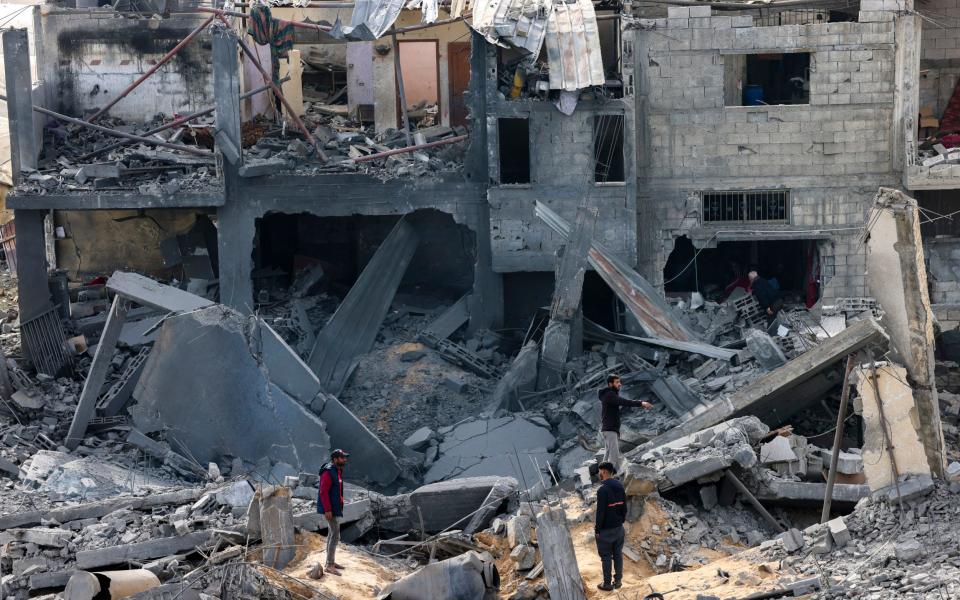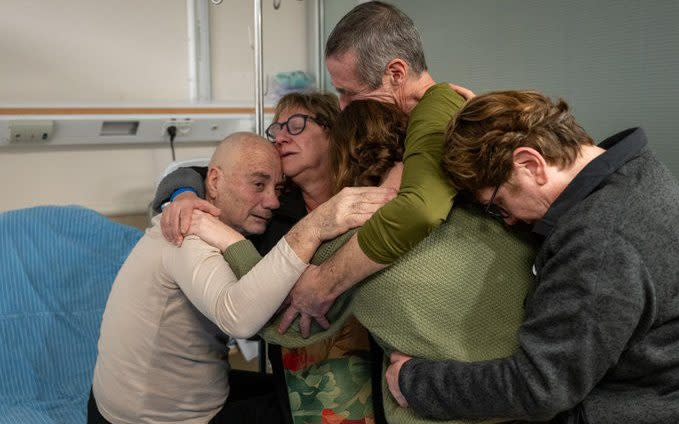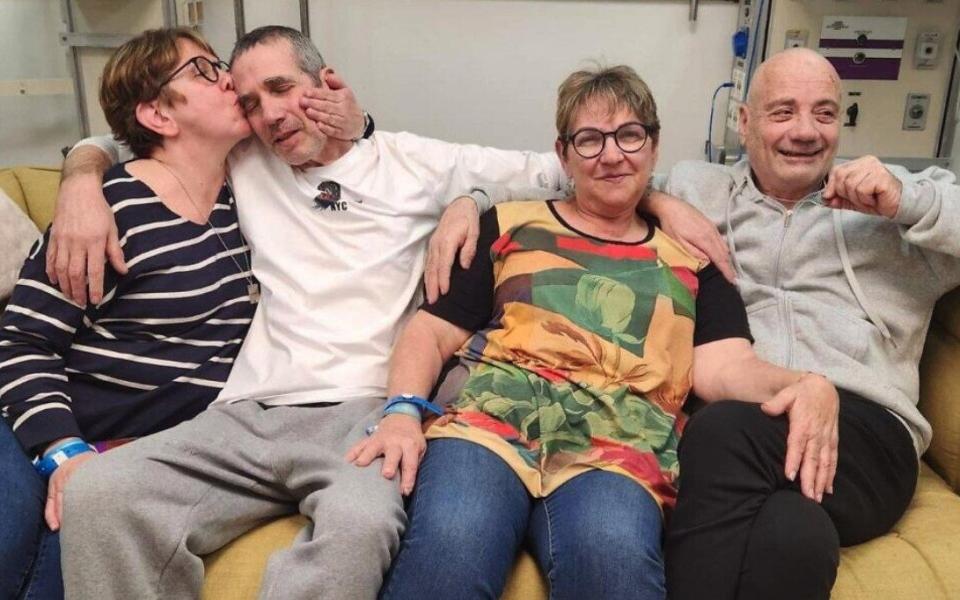How Israeli commandos blasted their way into Rafah apartment to rescue hostages
- Oops!Something went wrong.Please try again later.
At 1.49am on Monday, Israeli commandos climbed to the roof of a two-storey building in the middle of Gaza’s sprawling southern city of Rafah.
After entering the block, elite counter-terrorism soldiers descended to the second floor where they attached explosives to the door of an apartment.
The blast instantly killed three Hamas terrorists standing in the corridor on the other side.
Those men were guarding Fernando Marman, 60, and Louis Har, 70, who were kidnapped from their kibbutz of Nir Yitzhak, just across from Gaza, 129 days earlier.
“The diamonds are in our hands,” the commanders radioed back to HQ as they gathered up the hostages, using a pre-agreed codeword.
The daring raid marks one of the few occasions Israeli ground forces have entered Rafah, the southerly city butting up against the Egyptian border, since their war on Hamas began. Benjamin Netanyahu, Israel’s prime minister, is preparing to launch a full-scale assault on the city where one million Gazans are sheltering after fleeing the bombs across the rest of the strip.
The raid on Rafah was made possible by advanced Israeli intelligence. As commandos began their raid on the apartment complex they would also have been aware of a high number of Hamas fighters stationed in two other adjacent buildings.
The entire rescue was watched in real-time from an operational headquarters in Be’er Sheva in the Negev desert. Mr Netanyahu, the Israeli president, and the defence minister joined them at what was a “very tense and emotional night”, according to the IDF.
“At 1.40a.m. I saw you charging in and a few seconds later I heard: ‘We’ve got the hostages’,” Mr Netanyahu recalled in a meeting with some of the troops who led the rescue operation on Monday. He praised them for a “perfect operation”.
It was also an operation which saw yet more Palestinians killed in devastating distraction bombings that allowed the hostages to escape to the safety of a hospital in Israel.
The IDF said its commandos shielded the two hostages during heavy exchanges of fire at several locations.
Additional ground troops from the Navy’s Shayetet 13 commando unit and 7th Armoured Brigade provided cover as Hamas fighters targeted the operation from the surrounding buildings, injuring one soldier.
The commandos and the hostages were ordered back into the building by the operation’s commander and did not come out until around 1.50am, when Israel called in airstrikes as a diversion to help the soldiers and the hostages escape.
The devastating bombings destroyed 14 buildings and killed at least 67 Palestinians, authorities in Gaza said.

Gaza’s Hamas-controlled health ministry said on Monday the casualties mostly came from both the IDF airstrikes and exchange of gunfire during the extraction of the hostages.
Footage from the scene showed a dozen buildings reduced to rubble and houses left without windows.
One witness on the ground said the IDF stormed a building to rescue the hostages and later called in an airstrike to destroy it. Many of the casualties from the air strike appear to be civilians.
As dawn arrived on Monday, dozens of survivors and families were seen coalescing among the destroyed houses.
“I can’t tell you how we survived last night,” Abu Abdullah al Qadi said. “They killed my cousin. They killed a lot of people in the strikes.”
Abu Suhaib, 28, said he heard warplanes dropping bombs and helicopters hovering overhead.
“The situation was hell,” Mr Suhaib, who slept just dozens of metres from one of the air strikes, told AFP. “We heard the sound of the explosion, like hell falling down on civilians.”
The air strikes helped the commandos hurry the two men to awaiting armoured vehicles, which transported them to the border, just a few kilometres away.
A military helicopter with Israeli soldiers was waiting outside the fence to airlift the hostages to the Sheba medical centre near Tel Aviv, where the families were already ready to welcome their relatives back.
Israel had intelligence about the two men’s whereabouts and had been preparing the operation for some time, according to the Israeli military. They were waiting for the right conditions on the ground and had to abort a rescue mission last week.
The hostages had no idea. In a short interview, the unnamed commander of the rescue unit who led the operation, said on Sunday: “The door opened and we saw the hostages on the floor. For a few seconds, they didn’t understand what was happening… later they realised it was special forces that came to rescue them.”
The joint operation by the Yamam counter-terrorism unit, the Shin Bet security agency at the IDF is the first successful hostage rescue since a female Israeli soldier was saved from Gaza in the early days of the ground offensive in late October.
The families had no idea an operation to save their loved ones was afoot when they got a call in the middle of the night asking them to get to the hospital to meet them.
Mr Har’s son-in-law said his wife was shocked when she got the call informing her she should come to the Sheba medical centre to meet her father.
“She couldn’t speak,” Idan Bejerano told public broadcaster Kan. “She was in shock. We were tense for an hour, an hour and a half – until we met.”
The two released hostages looked “thin and pale” but seemed to be communicating well and aware of their surroundings, according to Mr Bejerano.


When he saw his son-in-law, Mr Har reportedly told him: “You have a birthday today, mazal tov!”
The IDF, in a message detailing the operation, said the excitement at the rescue should not outweigh the anxiety of the families of the remaining 134 hostages still in Hamas captivity.
“If you are listening to me, know that we are determined to bring you back home,” Mr Hagari said.
“We will not give up any opportunity to bring you back home.”
Meanwhile, Israel’s opposition leader said on Monday that Israel had a “narrow’ window of opportunity right now to negotiate a hostage deal with Hamas. Yair Lapid cited his recent conversations with Antony Blinken, the US secretary of state, and Emmanuel Macron, the French president, who told him now was the time frame where a deal could be made.
But Mr Netanyahu, emboldened by the success of the rescue operation, on Monday afternoon pledged to carry on with the war as he told the visiting Dutch prime minister that Israel “will not leave the terror battalions alone in Rafah”. Mark Rutte warned ahead of his trip to Israel that a ground operation in Rafah would have “catastrophic humanitarian consequences” and called for a ceasefire.
Mr Rutte’s visit coincided with a Dutch court ruling to suspend the exports of F-35 fighter jet parts to Israel amid fears that the jet parts were being used to violate international law in Gaza. The Dutch government has pledged to appeal the decision.

